Categories: All about LEDs
Number of views: 45797
Comments on the article: 2
How the LEDs are arranged and work
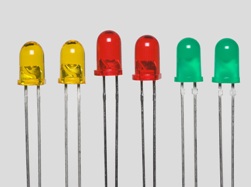 Light-emitting semiconductor devices are widely used for lighting systems and as indicators of electric current. They relate to electronic devices operating under the applied voltage.
Light-emitting semiconductor devices are widely used for lighting systems and as indicators of electric current. They relate to electronic devices operating under the applied voltage.
Since its value is insignificant, such sources belong to low-voltage devices, they have an increased degree of safety regarding the effect of electric current on the human body. The risks of injuries increase when sources of increased voltage, for example, a household home network, which require the inclusion of special power supplies in the circuit, are used to illuminate them.
A distinctive feature of the design of the LED is a higher mechanical strength of the housing than that of Illich and fluorescent lamps. With proper operation, they work long and reliably. Their resource is 100 times higher than that of incandescent filaments, reaching one hundred thousand hours.
However, this indicator is characteristic for indicator designs. High-power sources use high currents for lighting, and the service life is reduced by 2–5 times.
LED device
A conventional indicator LED is made in an epoxy case with a diameter of 5 mm and two contact leads for connection to electric current circuits: anode and cathode. Visually they differ in length. For a new device without cut contacts, the cathode is shorter.
A simple rule helps to remember this position: both words begin with the letter “K”:
-
cathode;
-
in short.
When the legs of the LED are cut off, the anode can be determined by applying 1.5 volts of voltage from a simple finger battery to the contacts: the light appears when the polarities coincide.
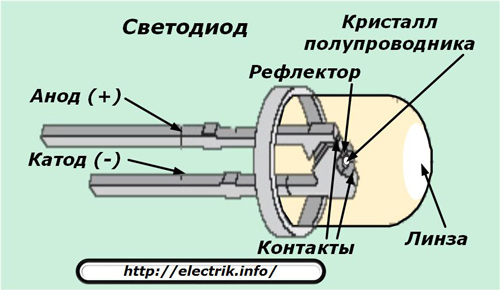
The light emitting active single crystal of a semiconductor has the form of a rectangular parallelepiped. It is placed near a parabolic reflector made of aluminum alloy and mounted on a substrate with non-conductive properties.
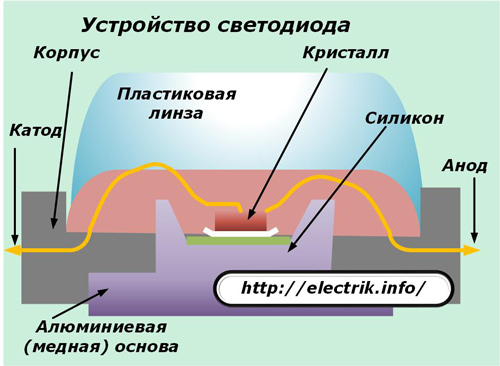
At the end of a transparent transparent case made of polymeric materials, there is a lens focusing light rays. It, together with the reflector, forms an optical system that forms the angle of the radiation flux. It is characterized by the directivity pattern of the LED.
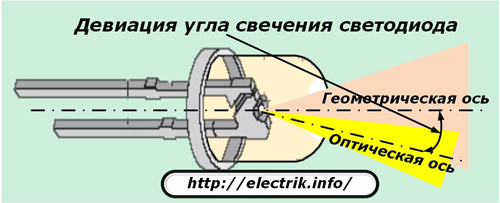
It characterizes the deviation of light from the geometric axis of the overall structure to the sides, which leads to an increase in scattering. This phenomenon occurs due to the appearance of small violations of technology during production, as well as the aging of optical materials during operation and some other factors.
An aluminum or brass belt can be located at the bottom of the case, serving as a radiator to remove heat generated during the passage of electric current.
This design principle is widespread. On its basis, other semiconductor light sources are also created using other forms of structural elements.
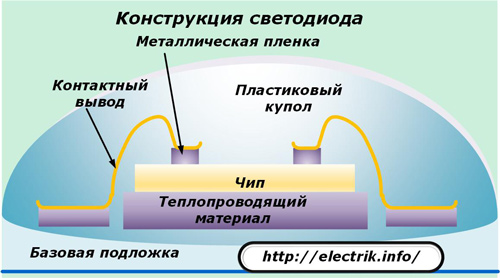
Principles of light emission
The p-n type semiconductor junction is connected to a constant voltage source in accordance with the polarity of the terminals.
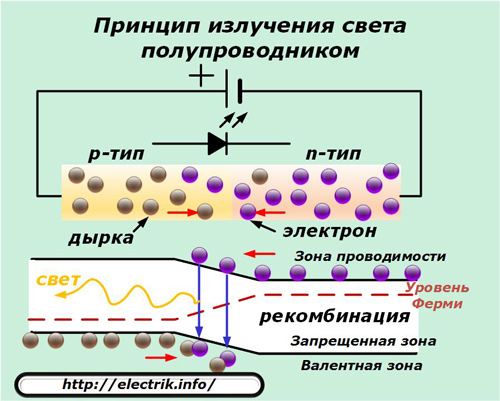
Inside the contact layer of p- and n-type substances, under its action, the movement of free negatively charged electrons and holes begins, which have a positive charge sign. These particles are directed toward their poles.
In the transition layer, the charges recombine. Electrons pass from the conduction band to the valence band, overcoming the Fermi level.
Due to this, part of their energy is released with the release of light waves of various spectra and brightness. Wave frequency and color reproduction depend on the type of mixed materials of which it is made p-n junction.
For radiation of light inside the active zone of a semiconductor, two conditions must be met:
1. the space of the forbidden zone in width in the active region should be close to the energy of the emitted quanta within the frequency range visible to the human eye;
2. The purity of the materials of the semiconductor crystal must be high, and the number of defects affecting the recombination process is the minimum possible.
This difficult technical problem is solved in several ways. One of them is the creation of several layers of p-n junctions when a complex heterostructure is formed.
Temperature effect
As the voltage level of the source increases, the current through the semiconductor layer increases and the luminescence increases: an increased number of charges per unit time enters the recombination zone. At the same time, current-carrying elements are heated. Its value is critical for the material of internal current conductors and the substance of the pn junction. Excessive temperatures can damage them, destroy them.
Inside the LEDs, the energy of the electric current passes into the light directly, without unnecessary processes: not like with lamps with incandescent filaments. In this case, minimal losses of useful power are formed due to the low heating of the conductive elements.
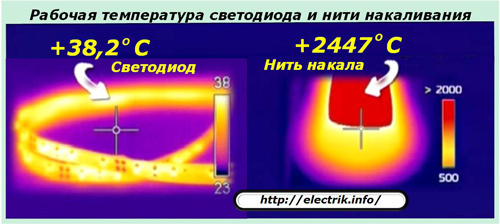
Due to this, high efficiency of these sources is created. But, they can be used only where the structure itself is protected, blocked from external heating.
Features of lighting effects
Upon recombination of holes and electrons in different compositions of the pn junction substances, unequal light emission is created. It is customary to characterize it by the parameter of the quantum yield — the number of extracted light quanta for a single recombined pair of charges.
It is formed and occurs at two levels of the LED:
1. inside the semiconductor junction itself - internal;
2. in the design of the entire LED as a whole - external.
At the first level, the quantum yield of correctly executed single crystals can reach a value close to 100%. But, to ensure this indicator, it is required to create large currents and powerful heat dissipation.
Inside the source itself, at the second level, part of the light is scattered and absorbed by structural elements, which reduces the overall radiation efficiency. The maximum value of the quantum yield is much less. For LEDs emitting a red spectrum, it reaches no more than 55%, while for blue it decreases even more - up to 35%.
Types of color light transmission
Modern LEDs emit:
-
yellow:
-
green;
-
red;
-
blue;
-
blue;
-
White light.
Yellow green, yellow and red spectrum
The pn junction is based on gallium phosphides and arsenides. This technology was implemented in the late 60s for indicators of electronic devices and control panels of transport equipment, billboards.
Such light output devices immediately overtook the main light sources of that time - incandescent lamps and surpassed them in reliability, resource and safety.
Blue spectrum
The emitters of the blue, blue-green and especially white spectra did not lend themselves to practical implementation for a long time because of the difficulties of complex solution of two technical problems:
1. limited size of the forbidden zone in which the recombination is carried out;
2. high requirements for the content of impurities.
For each step of increasing the brightness of the blue spectrum, an increase in the energy of quanta was required due to the expansion of the width of the forbidden zone.
The issue was resolved by the inclusion of silicon carbides SiC or nitrides in the semiconductor substance. But, the developments of the first group turned out to have too low efficiency and a small yield of quantum radiation for one recombined pair of charges.
The inclusion of zinc selenide solid solutions in the semiconductor junction helped to increase the quantum yield. But, such LEDs had an increased electrical resistance at the junction.Due to this, they overheated and quickly burned out, and the complex structures in the manufacture of heat removal for them did not work effectively.
For the first time, a blue LED was created using thin films of gallium nitride deposited on a sapphire substrate.
White spectrum
To obtain it, use one of three developed technologies:
1. color mixing according to the RGB method;
2. applying three layers of red, green and blue phosphor to the ultraviolet LED;
3. coating the blue LED with layers of yellow-green and green-red phosphor.
In the first method, three single crystals are placed on a single matrix at once, each of which emits its own RGB spectrum. Due to the design of the lens-based optical system, these colors are mixed and the resulting output is a total white tint.
In an alternative method, color mixing occurs due to successive irradiation with ultraviolet radiation of the three constituent phosphor layers.
Features of white spectrum technology
RGB technique
It allows you to:
-
involve various combinations of single crystals in the lighting control algorithm, connecting them alternately manually or with an automated program;
-
cause various color shades that change over time;
-
create spectacular lighting systems for advertising.
A simple example of such an implementation is color christmas garlands. Similar algorithms are also widely used by designers.
The disadvantages of RGB LEDs are:
-
heterogeneous color of the light spot in the center and edges;
-
uneven heating and heat removal from the matrix surface, leading to different aging rates of p-n junctions, affecting color balancing, changing the overall quality of the white spectrum.
These disadvantages are caused by the different arrangement of single crystals on the base surface. They are difficult to fix and configure. Due to this technology, RGB models are among the most complex and expensive designs.
LEDs with phosphor
They are simpler in design, cheaper to manufacture, more economical when converted to radiation units of luminous flux.
They are characterized by disadvantages:
-
in the phosphor layer there are losses of light energy, which reduce light output;
-
the complexity of the technology for applying a uniform phosphor layer affects the color temperature quality;
-
The phosphor has a shorter life than the LED itself and ages faster during use.
Features of LEDs of different designs
Phosphor models and RGB products are created for various industrial and domestic applications.
Nutrition Methods
The indicator LED of the first mass releases consumed about 15 mA when powered from a slightly lower value than two volts of constant voltage. Modern products have enhanced characteristics: up to four volts and 50 mA.
LEDs for lighting are powered by the same voltage, but already consume several hundred milliamps. Manufacturers are now actively developing and designing devices up to 1 A.
In order to increase the efficiency of light output, LED modules are created that can use a sequential voltage supply to each element. In this case, its value increases to 12 or 24 volts.
When applying voltage to the LED, the polarity must be taken into account. When it is broken, the current does not pass and there will be no glow. If an alternating sinusoidal signal is used, then the glow only occurs when a positive half-wave is transmitted. Moreover, its strength also proportionally changes according to the law of the appearance of the corresponding current magnitude with a polar direction.
It should be borne in mind that with reverse voltage, a breakdown of the semiconductor junction is possible. It occurs when exceeding 5 volts on one single crystal.
Management methods
To adjust the brightness of the emitted light, one of two control methods is used:
1. the magnitude of the connected voltage;
2. using Pulse Width Modulation - PWM.
The first method is simple but inefficient. When the voltage level drops below a certain threshold, the LED can simply go out.
The PWM method eliminates this phenomenon, but it is much more complicated in technical implementation. The current passed through the semiconductor junction of the single crystal is supplied not by a constant shape, but by a pulsed high frequency with a value from several hundred to a thousand hertz.
By changing the width of the pulses and the pauses between them (the process is called modulation), the brightness of the glow is adjusted over a wide range. The formation of these currents through single crystals is carried out by special programmable control units with complex algorithms.
Emission spectrum
The frequency of the radiation emerging from the LED lies in a very narrow region. It is called monochromatic. It is fundamentally different from the spectrum of waves emanating from the Sun or the incandescent filaments of ordinary light bulbs.
There is a lot of discussion about the effect of such lighting on the human eye. However, the results of serious scientific analyzes of this issue are unknown to us.
Production
In the manufacture of LEDs, only an automatic line is used, in which robot machines work according to a pre-designed technology.
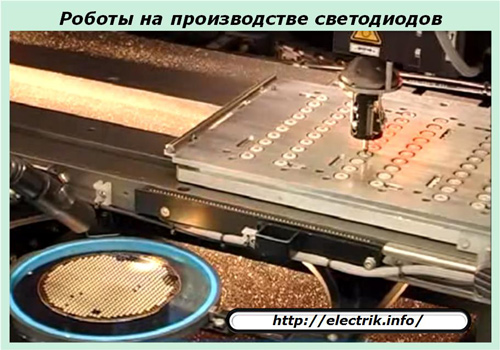
The physical manual labor of a person is completely excluded from the production process.
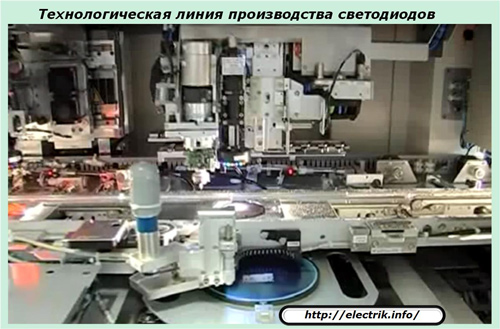
Trained specialists carry out only control over the correct course of technology.

Analysis of the quality of products is also their responsibility.
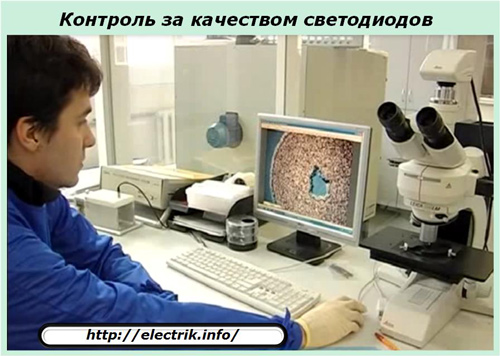
See also at bgv.electricianexp.com
:
